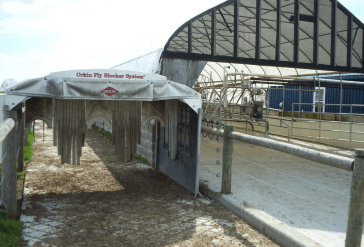



Ecological Control of Pasture Flies
Farmers that raise animals know that June is when flies start to be a nuisance, and by July, if a control program is not in place, production losses occur. The information from this pasture walk will help farmers put a fly control program into place.Speaking at the pasture walk was Dr. Phil Kaufman, veterinary entomologist with Cornell University and Keith Waldron, NY Integrated Pest Management extension specialist. This team has been working together to present this topic for a number of years. Throughout the presentation, they repeated the need to clean up around the farm. Two of the three most common flies affecting animals on pasture, face fly and horn fly, breed in undisturbed manure piles. The third, stable flies, breed in moist rotting organic material, like moist straw bedding, the base of big bales stored on the ground, and poorly composted grass clippings.
Dr. Kaufman stressed the importance of managing fly control ecologically since organic methods are not as effective against populations that are already out of control. Chemically, it takes large doses of chemicals and the results will be less and less successful as the flies become resistant to pesticides. By reducing breeding areas, populations will be decreased, reducing the need for insecticide use, which will improve the effectiveness of chemicals.
The following are ecological control methods and thresholds for when numbers of flies will affect production losses.
Face flies, found (you guessed it) on the face, would become a problem at 10 flies on the face at one time. The female face fly is the most commonly seen. She is there to feed on the protein that is in the mucus around the eyes and nose, which she uses for reproduction. If there is not enough mucus, she pokes around the eyes, irritating them and causing them to tear, which is what the fly is after. This feeding behavior is how pink-eye is spread.
Horn flies are found on the animal’s back and belly areas. They become a problem when they reach 50 per side in dairy animals and 100 per side in beef animals. Both sexes have biting mouthparts that they use to pierce the skin to obtain blood meals. You may notice horn flies billowing up from the backs of cows as they enter the barn, since horn flies do not like dark areas. A number of non-chemical traps have been designed to take advantage of this behavior. Both the face and horn fly females lay eggs on undisturbed cattle dung. Female horn flies wait by the tail head or lower rear of the animal to await dung deposition so that they can lay their eggs on the dung within seconds of it landing on the ground.
Both of these flies affect only animals on pasture and are outdoor insects. Control of face flies is difficult if other animal owners in the area don’t have a program in place, since the face fly females leave the host daily and can fly up to 5 miles to find animals the following day. Because horn flies stay with the animals, their movement between herds is more restricted than face fly movement.
The stable fly is a pest on pasture animals and will also attack animals in confinement. Found on the legs of cattle, they are considered to be an economic problem when there are an average of 10 or more flies per animal, counted on the legs of 15 animals. Like the horn fly, they are blood feeders. If you see your animals stomping or standing in water or muddy areas, it often means they are being bitten by stable flies. Ecological control of this pest requires cleaning up rotting organic material, such as silage left around the blower, calf hutches, or round bale feeders left in the same place for too long.
The group went out into Bill and Joanne’s pasture to look at dung pats to see what interesting things we could find. Under the pats there were small holes that were made by a beetle that lays its eggs into dung balls and buries them in the ground. Dr. Kaufman said there were more than 125 different species that live part of their life cycle in the dung pat, of these, only three were considered pests. For this reason, he cautioned people not to disturb the manure pats as a way of controlling just the three pests.
One question that most farmers came with was, “What are those yellow fuzzy flies that are seen on cattle dung early in the spring and then later again in the fall?” This year, there seems to be more of them than usual, one producer felt that it might be a harbinger of fly problems to come. It turns out that they are Yellow Dung flies, a predator that sits on the dung pat and waits for flies to come along and pounces on them to eat. Parasitic wasps and other non-pest flies were also discussed at the pasture walk. It was stressed that the parasitic wasps are an important part of a successful fly control program, but only in confined systems.. The control program that was recommended was:
- Cleaning up breeding areas
- Identify pest, and know its life cycle
- Monitor numbers, keep track of thresholds
- Use organic chemical controls as last resort
The earlier your program is in place, the more success it will have.


